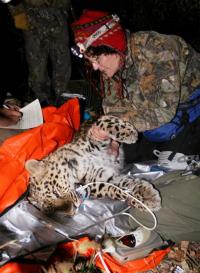
Conservationist examing a recently captured Amur leopard in Russia. A rare Amur leopard (Panthera pardus orientalis), one of only an estimated 30 left in the wild has been captured and health-checked by experts from a consortium of conservation organizations, before being released.
Representatives from a group of organizations, including the Russian Academy of Sciences Institute of Biology and Soils, the Wildlife Conservation Society (WCS) and the Zoological Society of London (ZSL) captured the female in a remote location in south-west Primorye as part of their work to save the critically endangered leopard. The animal was tranquilized and an extensive and high-tech medical examination undertaken by the veterinary team.
Alexei Kostyria, biologist from the Institute of Biology and Soils in Vladivostok and co-leader of the project, commented, “This capture represents a new benchmark in assessing health of wild animals in Russia. We have brought together top experts from Russia and around the world and taken state-of-the-art equipment deep into the taiga to conduct medical assessments of the Far Eastern leopard. We have an unprecedented level of collaboration and remarkable effort that is essential if we are to save this critically endangered leopard.”
Kostyria’s counterpart, John Goodrich of the Wildlife Conservation Society, commented, “Catching this female was a big step forward in our efforts to understand the status of this population, and to better define necessary conservation actions needed to conserve this population.”
There are estimated to be between 24 and 32 Amur leopards living in the wild, making this population the rarest big cat on the planet. The animals are found in a corner of the Russian Far East on the Chinese border, in an area where their range is restricted by human activity. As the wild population is so small, it is likely that inbreeding (breeding between close relatives) is taking place and it is important to find out if this is having damaging effects on the cats in order to plan conservation action for the future. The Wildlife Conservation Society and the Zoological Society of London are working with local organizations to initiate a wildlife health monitoring program involving leopards and other wildlife in the region.
Initial findings from the veterinary examination of the leopard include the presence of a heart murmur, which could be indicative of inbreeding depression. Remarkably given the remote location, the team was able to capture footage of the heart, using a portable sonogram device, which has already been sent out for review by heart specialists. Further results are expected once laboratory analysis has been carried out, which will provide more information about the reproductive condition of the leopard as well as any illnesses or parasites that she may have been suffering from.
Source : Wildlife Conservation Society
 Print Article
Print Article Mail to a Friend
Mail to a Friend
